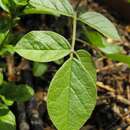en
names in breadcrumbs


Glycoyrrhiza uralensis, or Asian Licorice, is a legume native to central Asia, China, and Japan. The root has been used in traditional medicine throughout Asia and the Middle East for thousands of years. In China, licorice is second in popularity only to ginseng and written record of it's use goes back as far as 3,000 years. It was used to treat wounds, strengthen bones, and promote muscle growth.
Licorice root has historically been used for a wide range of ailments from respiratory distress to digestive irritation and is still popular today in herbal remedies for boosting the immune system, improving mental functions, and countering stress, among numerous uses. Botanical researchers have analyzed licorice and identified many active compounds.
A key compound, glycyrrhizin, is responsible for licorice's distinctive sweetness. The genus name "Glycyrrhiza" means "sweet root" in Greek, but most licorice candy today is flavored with anise instead.
Glycyrrhiza uralensis, also known as Chinese liquorice,[2] is a flowering plant native to Asia. It is used as a sweetener and in traditional Chinese medicine.[3]
Liquorice root, or 'radix glycyrrhizae', is one of the 50 fundamental herbs used in traditional Chinese medicine, where it has the name gancao (kan-tsao; Chinese: 甘草, pinyin: gāncǎo). It is used in Chinese medicine to harmonize other herbs and to reduce the harsh effects of other herbs.[3] It is usually collected in spring and autumn, when it is sliced and sun-dried, then either used unprepared or stir-baked with honey.[4] Liquorice root is most commonly produced in the Shanxi, Gansu and Xinjiang regions of China.[5]
Liquorice root contains glycyrrhizin, which may affect blood pressure, blood potassium levels or have untoward effects during pregnancy.[6] Overuse of licorice may induce weakness, headache, blurred vision, nosebleed, anxiety, or shortness of breath.[7] Other common side effects may include missed menstrual periods, fluid retention or sexual problems in men.[7] More serious instances of overuse can lead to hypertension and hyperaldosteronism, which may require hospitalization.[8]
Glycyrrhiza uralensis can be found growing naturally in Europe, Asia, and throughout the Middle East. This Chinese licorice is harvested mainly during the spring and autumn and is dried by sunlight. The plant is very strong rooted, and grow to be 30-120 cm tall.[9]
The plant contains a glycoside that is 30-50 times sweeter than sucrose, glycyrrhizin, which has the chemical composition C42H62O16.[10][11] The plant contains numerous phytochemicals.[11]
{{cite web}}: CS1 maint: archived copy as title (link). 25 April 2010. Glycyrrhiza uralensis, also known as Chinese liquorice, is a flowering plant native to Asia. It is used as a sweetener and in traditional Chinese medicine.